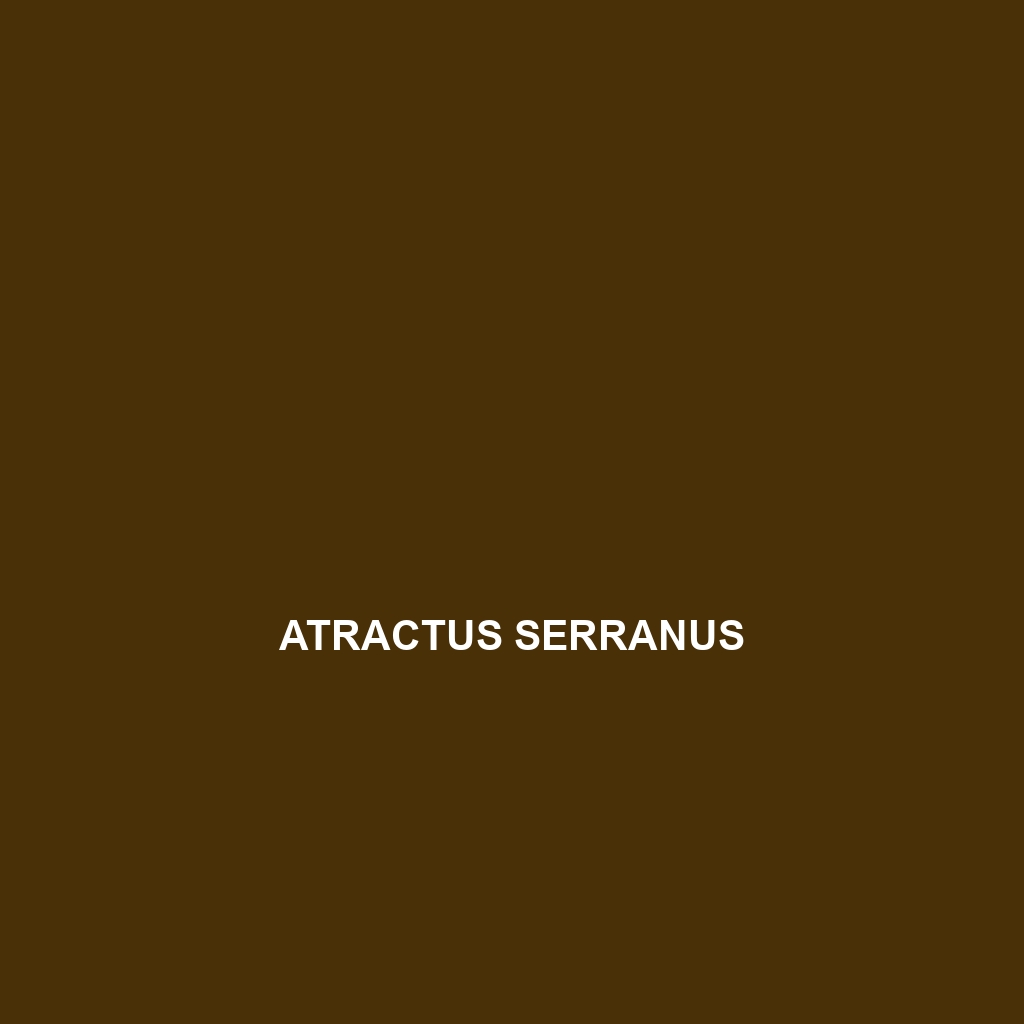-

Atractus zidoki
Discover the fascinating Atractus zidoki, a slender, medium-sized snake native to the tropical rainforests of Colombia, characterized by its striking dark patterns and elusive, nocturnal behavior. This carnivorous species plays a vital role in regulating invertebrate populations and is currently classified as Vulnerable due to habitat threats.
-

Atractus wagleri
Introducing the Atractus wagleri, or Wagler’s snail-eating snake, a slender, nocturnal serpent native to Central America’s humid forests, recognized for its distinct dark brown scales and cream-colored stripes. This non-aggressive species primarily feeds on snails and plays a vital role in regulating their populations, contributing to the ecological balance of its habitat.
-

Atractus steyermarki
Discover the Atractus steyermarki, or Steyermark’s snail-eater, a vulnerable snake species native to the tropical rainforests of Venezuela and the northern Andes. This nocturnal predator, measuring 30 to 50 cm, plays a crucial role in its ecosystem by controlling snail populations and thrives in humid environments rich in leaf litter and debris.
-

Atractus schach
Discover the fascinating Atractus schach, a fossorial snake native to the tropical rainforests of South America, known for its slender body, distinctive dark bands, and diet consisting primarily of earthworms and small invertebrates. This elusive species plays a vital role in its ecosystem by controlling invertebrate populations and serving as prey for larger predators.
-

Atractus serranus
The Atractus serranus, known as the “mountain snake,” is a slender, nocturnal species found in the humid forests of the Andes, primarily feeding on small invertebrates and amphibians. With its striking dark coloration and vulnerability due to habitat loss, it plays an essential role in maintaining ecological balance in its high-altitude environment.
-

Atractus resplendens
Discover the stunning Atractus resplendens, a vibrant snake native to the humid forests of Colombia, known for its striking dark brown and yellow coloration. With a diet primarily consisting of small invertebrates, this nocturnal species plays a vital role in its ecosystem, controlling insect populations and serving as prey for larger predators.
-

Atractus poeppigi
Discover the Atractus poeppigi, a nocturnal snake from the tropical rainforests of the Amazon Basin, recognized for its slender body, distinctive light and dark band patterns, and its role in controlling invertebrate populations. This secretive species, which reaches lengths of 40 to 50 centimeters, is a master of camouflage, thriving in moist environments while contributing…
-

Atractus pauciscutatus
Loading…
-

Atractus obtusirostris
Discover the Atractus obtusirostris, a slender, nocturnal snake native to the tropical rainforests of Central and South America, characterized by its blunt snout and camouflaging coloration. This fascinating species primarily feeds on small invertebrates, plays a vital role in its ecosystem, and is classified as vulnerable due to habitat loss.
-

Atractus occidentalis
Atractus occidentalis, commonly known as the Western Snake, is a slender, nocturnal snake native to the humid forests of Central America, particularly in Panama and Colombia. Recognized for its distinctive brown and black coloration, this vulnerable species primarily feeds on small invertebrates and plays a vital role in maintaining ecological balance within its habitat.
Search
Popular Posts
-
Lygosoma corpulentum
Discover the Lygosoma corpulentum, or fat skink, a robust insectivorous lizard native to Southeast Asia’s moist tropical rainforests and varying habitats. With a stocky body, impressive camouflage, and remarkable adaptability, this ovoviviparous species plays a crucial role in maintaining ecological balance.
-
Lygosoma boehmei
Lygosoma boehmei is a slender, nocturnal insectivore found in humid tropical rainforests and savannas of Southeast Asia, exhibiting a smooth, camouflaging texture and remarkable burrowing abilities. This vulnerable species plays a crucial role in its ecosystem by controlling insect populations and serving as prey for larger predators.
-
Lygosoma bampfyldei
Lygosoma bampfyldei, commonly found in tropical and subtropical regions, is a moderately sized lizard measuring 15 to 25 cm, known for its elongated body and glossy, camouflage coloration. This insectivorous species thrives in moist habitats and plays a vital role in maintaining ecological balance by controlling insect populations.
Categories
Tags
animal adaptations (924) animal behavior (5000) animal reproduction (865) behavior (920) biodiversity (7853) conservation (1670) conservation efforts (1778) conservation status (5748) diet (2104) ecological balance (2087) ecological role (1952) ecosystem (1469) ecosystem role (2901) endangered species (2514) habitat (3280) habitat conservation (1136) Habitat Destruction (1421) habitat loss (3385) herpetology (870) insectivorous reptiles (948) IUCN Red List (1971) lizard behavior (881) lizard diet (944) lizard reproduction (1101) nocturnal animals (2754) nocturnal behavior (2592) nocturnal reptiles (1061) physical characteristics (2058) predator-prey relationships (927) reproduction (2890) reptile behavior (1037) reptile conservation (1348) reptile reproduction (1069) rodent species (1325) seed dispersal (2145) Seed Disperser (979) small mammals (1168) snake behavior (952) snake diet (1061) snake reproduction (1129) tropical forests (948) Vulnerable Species (4926) wildlife (2511) wildlife conservation (5355) wildlife protection (1008)


